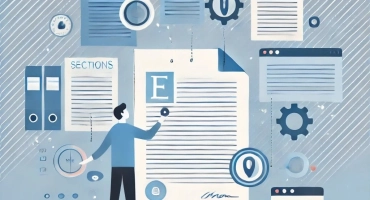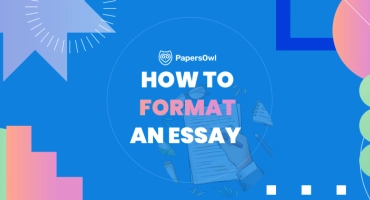MLA Style Essay Made Easy: Walkthrough of MLA Formatting
Table of contents
- 1 Understanding MLA Format
- 2 Basic MLA Formatting Guidelines
- 3 In-Text Citations
- 3.1 General Guidelines for MLA Citations
- 3.2 The Author Page Citation Format Rule
- 3.3 Standard Citation Format For Print Sources
- 3.4 Citing a Work by Multiple Authors in MLA
- 3.5 MLA Guidelines for Print Sources With Unknown Authors
- 3.6 Citing Works With the Same Last Names
- 3.7 Citing Multiple Works by the Same Author in MLA
- 3.8 Citing Multivolume Works in MLA
- 3.9 Citing the Bible
- 3.10 Citing Indirect Sources
- 3.11 Citing Electronic Sources
- 4 Quoting and Paraphrasing
- 5 MLA Works Cited Page Guidelines for Different Types of Sources
- 6 Bibliographic & Content Notes
- 7 Common MLA Abbreviations
- 8 Formatting Numbers in MLA
- 9 Lists in MLA
- 10 MLA Formatting Takeaway
The MLA format is the most common type of formatting used for academic papers. Every student in the US should become familiar with this format for the research papers and essays they submit. It should be referred to when citing sources and formatting papers in literature, language, and the arts. This format is crucial for understanding the guidelines of citation. It can also help students present their work in an organized and straightforward manner. Throughout this formatting guide, we’ll explore the key areas of how to write in MLA format effectively.
Understanding MLA Format
Every new high school student asks, “What is MLA format?“. The Modern Language Association format provides guidelines for formatting styles and citations that students can use for academic writing. It’s mainly used for subjects in humanities and liberal arts. Students must use this type of formatting when writing research papers for languages, literacy studies, visual arts, media studies, and similar courses. Scientific research doesn’t require students to write a paper in MLA format.
The MLA format for papers has been introduced previously. A group of teachers and like-minded students founded the Modern Language Association in 1883. This group’s mission was to promote the studies of language and literature. They developed the original MLA formatting guide to provide a basic outline of how to cover research papers. These MLA paper formatting guidelines were used to help students create organized research papers.
Of course, things have changed a lot since 1883. The MLA Handbook has kept up with the times. It has undergone several revisions and updates throughout the years. The most recent update was in 2021, when the 9th edition of the handbook was released. The MLA 9 essay format edition included valuable information for the modern student, such as citing digital sources. Now, students can also access digital tools for formatting, like the MLA citation generator and other online resources.
Throughout the years, there has been consistency with the MLA Handbook. Its purpose is to provide guidelines for students who must properly format your papers in MLA format and credit sources. Using this format helps students ensure that the presentation of their work is accurate and consistent.
Basic MLA Formatting Guidelines
There are specific criteria every MLA format essay must include. This section will cover some essential MLA formatting rules that every student should become familiar with. These rules are set so that every MLA paper has a consistent layout. They ensure good readability and organization.
Margins & Font
A student should never submit a research paper covered in a font from the top corner to the bottom. Every paper must have a 1-inch margin. The margins for MLA writing format should be on every side of the paper (one inch from the top, bottom, left, and right).
Always follow your professor’s instructions for font style and size. If no instructions are stated, the general MLA format font size rule is to use Times New Roman 12-point. You may use a different professional-looking font if your professor has approved it.
Title Page Requirements
The correct MLA format doesn’t require students to craft a title page. Instead of a separate page, students should present the following information in the top left corner of the first page before the first MLA header:
- Student’s name
- Professor’s name
- Course name
- Date
This information should always be stated above the paper’s title when writing in MLA format. The title must be entered on the following line. Always ensure the essay title is centered, uses title case-sized font, and double-spacing.
Page Numbering & Headers
The MLA formatting instructions also require students to use the ‘running head’ rule to number their pages. Each separate page of the essay in MLA format will be numbered. The page number will appear in the upper right-hand corner, with the student’s last name in front of it. The first page of the MLA paper should look similar to this:
Campbell- 1
Proper Spacing & Indentation
The MLA format paper should always be double-spaced. The double space leaves room for the professor to add notes. Students also need to use a 1/2-inch indent from the left margin for the first sentence of every paragraph.
In-Text Citations
With every research paper, students must cite their sources using in-text citations. This is how credit can be given to the original author. It’s also a good indicator of where the facts and research came from. The MLA format requirements state that students must use specific guidelines for citing sources.
General Guidelines for MLA Citations
A general citation can be used for print or digital. It will include the author’s last name and page numbers that contain the information. You will only need to reference the page number if you mention the author’s name in the sentence with your citing information.
The Author Page Citation Format Rule
The author page citation format is a simplified version of a general MLA citation. For this one, students only need to state the author’s last name and the page number where the information can be found. The author page citation will look like this:
King 29
Standard Citation Format For Print Sources
The MLA formatted paper guidelines are for citing sources from a book or print media. The in-text citation should include the author’s name and the page number with the information. It should also include the book title, edition (if specified), publisher, and year of publication. Here is an example of a standard citation for print.
Last Name, First Name, Book Title, Publisher, Year, Page (or page range)
Citing a Work by Multiple Authors in MLA
Sometimes, a student needs to cite sources that more than one author wrote. How you cite the source will depend on how many authors are included in the work. You can have both names and the page number if there are only two authors. Here is an example:
Barnes and Roth, 37
It’s essential to avoid using too many commas when citing sources. If three or more authors write the work being cited, you will only include some of their names. Instead, you will mention the first author’s last name followed by “et al”. It should look like this:
Barnes et al, 37
MLA Guidelines for Print Sources With Unknown Authors
There may be occasions where a student needs to cite sources that have unknown authors. For these situations, put the title of the work being referenced and the page number. The citation should look like this:
Title Work, 37
Citing Works With the Same Last Names
The MLA format has a very specific rule for citing text written by multiple authors with the same last name. With this type of work, mention the title and the edition number (if applicable) after the last name. Don’t forget to mention the page number as well. Here is an example of what it should look like:
Barnes, Title Work, 3rd ed., 37
Citing Multiple Works by the Same Author in MLA
Occasionally, students may need to reference multiple works from the same author. Each piece of work should have its citation. However, students can group them by using the word ‘and’. Here is an example:
(Barnes, Title Work 37) and (Barnes, Text Example 58)
Citing Multivolume Works in MLA
If an author has several volumes of a title piece, you must include the volume number in your citation. This is very easy to do. All that is required is to put the volume number between the author’s name and the page number. It should look like this:
Barnes vol 3 37
Citing the Bible
Citing a passage from the bible is slightly different than other pieces of work. In this citation, the student won’t give credit to an author. Instead, they will mention the verse, chapter, and page. For example:
Matthew 5:3-10
Citing Indirect Sources
According to the MLA Handbook, students should always use material from the source. But, sometimes, this isn’t possible. An indirect quote or indirect source is when you receive the information secondhand. For this type of citation, students should always use “qtd. in” along with the source they read. It should look similar to this:
qtd. in Roth 59
Citing Electronic Sources
When researching papers online, students must provide relevant information about the URL they used. An electronic source citing MLA format should include the following information:
- Author’s name
- Article title
- Website’s name
- Date of access
- URL
Here is an example of how to make a webpage citation when citing online sources for essays:
Barnes, Title Work, Webpage Name, 20 October 2023, www.examplesite.com/example123
Quoting and Paraphrasing
Quoting and paraphrasing are common in academic writing. Proper quoting and citations in MLA format are imperative because they help students avoid plagiarism. If you’re unsure about how to quote or cite correctly, you can always turn to a write my essay online service for expert help with your work. Quotes can help students incorporate outside information into their work. The MLA Handbook has specific guidelines for using quotes in academic papers.
Proper MLA Formatting of Quotations
Everyone must follow proper formatting rules to avoid plagiarism when writing a paper in MLA format. Luckily, these rules aren’t complicated. The quote should always have a parenthesis at the end that includes the author’s last name and the page number. Another way that’s acceptable to format a quote is if the author’s name and page number are used in the sentence before the quote. Here are two examples of quotation formatting that can be used:
- “This is an example quote.” (Barnes, 37)
- According to Barnes on page 37, this is how you use quotation marks. “Example quote placed here.”
Brief Quotations
A brief quote usually consists of less than three lines of text. The best way to format these quotes is to integrate the author’s name in the sentence leading up to the quote, followed by the exact quote in quotation marks. It should look similar to this sample MLA format:
According to Barnes, “There are many different quotes that can be acceptable to use in academic writing. Students should always use quotes to avoid plagiarism.”
Long Quotations
A long quote will contain three or more lines of text. The formatting for these quotes is different from a brief quote. Students will need to separate the quote from the rest of the paper. After a sentence leading up to the quote, it should begin on the following line (double-spaced). Always indent the quote one inch from the left margin.
Students can approach this quote with a parenthesis at the end of an introductory sentence. Always use the style that works best with the research paper being presented.
The long quotation should look similar to this:
“Every good research paper should include relevant quotes from an author or other professionals. This gives the reader more insight into the topic being discussed. It also helps the student avoid plagiarism when they want to share another person’s idea to support their research topic.”
(Barnes, 37)
Adding or Omitting Words in Quotes
Students may need to add or omit words in the quote for their MLA paper. Extra words may need to be added to a quote to help the reader better understand what the quote is referencing. When adding words to a quote, always add brackets to show that they are separate from the original statement. Here is an example of how and when to add words to a quote:
Original quote: “The new workspace should help them stay productive.”
Quote with added words: “The new workspace should help them [shop employees] stay productive.”
Omitting words could be necessary if the student needs to shorten the text for block quotations. They can keep the quote brief and to the point by omitting words. In this situation, nothing is done to show words have been removed. Quotes should be as original as possible. Only remove words if they add no value to the text. Here is an example of when it’s appropriate to remove words from a quote:
Original quote: “It’s easier to access online games using a mobile app on your smartphone.”
Quote with omitted words: “It’s easier to access games using an app on your smartphone.”
The example above shows that the quote’s message is read similarly to the omitted words. Removing the text doesn’t change the tone or message of the quote. Never omit words if the quote reads differently. For example, removing the phrase “mobile app” from the original quote above would completely change what’s being said.
MLA Works Cited Page Guidelines for Different Types of Sources
The works cited page is used as a reference list. Students will provide all the sources they used to get information for their MLA-style essay. This list aims to help readers locate the sources to verify the information. It proves the students didn’t make up any information shared in their essays.
A proper MLA format for the works cited page will include every resource used during the research process. This will include:
- Books
- e-Books
- Newspaper articles
- Magazine articles
- Websites
- Videos
- Films
- Interviews
Every MLA research paper should contain cited sources in a specific order. This will be further explained in the sections below.
Works Cited Entries in MLA 9th Edition Style
According to the most recent edition of the MLA format for an essay, the cited page should contain a list of sources alphabetically. All authors should be listed from A to Z. For sources with unknown authors, students can use the title to determine where it belongs.
The MLA format requires all sources listed on the cited page to be double-spaced. A hanging indent must be used for each new source added to the list.
Books and e-Books
A specific MLA citation format can be used for referencing information from books and e-books. Every book citation should include the following information in this order:
- Author’s name (last name first- i.e., Barnes, Michael)
- Book Title
- Publisher
- Publication Date
- Book Format (print or e-book)
Here are a few citation examples for books and e-books:
- Hill, Nathan. Wellness: A Novel. Bond Street Books. 2023. Print.
- Sokunbi, Bola. Clever Girl Finance: Ditch Debt, Save Money, and Build Real Wealth. Wiley. 2019. E-Book.
- Harris, Jillian and Wesszer, Tori. Fraiche Food, Fuller Hearts. Penguin Canada. 2023. Print.
Students can also simplify this process using a book citation generator or other online resources.
Journal Articles
Journal works are frequently referenced in students’ papers. All of the required information must be included when a journal or magazine article is mentioned on the cited list using the MLA research paper format. Every journal article reference should contain the following parenthetical citations in order:
- Author’s last name and first initial (i.e. Barnes, M)
- Article title: Subtitle (if applicable) in quotation marks
- Journal name
- Volume & issue
- Month
- Year
- Page
- DOI (digital object identifier) for online journals
The following examples show how journal articles should be mentioned on the cited page.
With subtitle: Jones, T. “The Importance of Citing Sources: A Beginner’s Guide To The Cited Page”. Teacher’s Journal Deluxe. Vol 12, no. 3. May, 2017. pp 30-33.
Without subtitle: Barnes, M. “How Professors Want You To Cite Sources”. Academic Journal. Vol 9, no. 11. Sept., 2020. pp 14-15.
Students can also use this format to cite a newspaper, magazines, and other print articles.
Websites & Online Sources
Students can now access more information online to help them research their essays. Sources online are acceptable as long as the web page is cited using the MLA paper format. When finding online resources, it’s common to come across recycled information. Always use the source to make your cited page as credible as possible. The best type of online sources to use are .gov and .org websites. Using .com/.ca/.co websites is acceptable if it’s a credible source or brand (i.e., www.nationalgeographic.com or www.forbes.com). Try to avoid citing blogs or social media posts unless you are directly quoting the person posting from the account.
According to the MLA format guidelines, the following information should be stated in order when you make web page citationa for every research paper:
- Author’s Name (if available)
- Source Title
- Website Title
- Publication Date
- URL
Here is an MLA format example of how an online source should be cited in the MLA footnotes.
Barnes, Michael. “How To Cite Sources”. Proper Formatting Online, 10 May 2023, www.examplesite.com/how-to-cite-sources.
Films & Multimedia
Since students should use the MLA essay format on art subjects, there may be times when they need to generate citations from Video. This is very common in media studies. When referencing film, always include the following information in order:
- Director’s name
- Film title
- Production Company
- Year of release
- Format of the source used (i.e., DVD, Blu-ray, digital)
Here are a couple of examples of how to reference a film on the cited page:
- Craven, Wes, director. Scream. Miramax. 1996. DVD.
- Gerwig, Greta, director. Barbie. Warners Bros. 2023. Google TV.
Students may also reference multimedia posted online, such as YouTube videos. The creator’s name may not be available when referencing an online video. In this situation, it’s acceptable to cite their username. The following information should be cited in order when referencing an online video.
- Creator’s name or username
- Video title (in quotation marks)
- Platform or website name
- Channel (if applicable)
- The date the video was posted
- URL
Here is an example of how to generate citations from video through online multimedia:
Warner Bros Entertainment. “Singin’ in the Rain | Good Mornin'”. YouTube. 2022. https://www.youtube.com/watch?v=pyMU8O2B2Vs
A similar format can be used for works cited from podcasts, radio shows, and other online video and audio media.
Interviews & Personal Communication
Certain projects will require students to conduct personal interviews. It’s still necessary to cite sources when using information from interviews. A student can also directly quote their interview subject in the research paper. There are several ways that students can interview people for research. This includes:
- In-person
- Online chat
- Video chat
- Phone
Personal interviews and communications are an efficient way to get valuable insight and real information on a topic. Citing these communications is also very easy. Mention the interviewee’s name (last name, first name) followed by the type of communication and the date of contact. Students can also add any other relevant information that could be useful to the reader (i.e., business name, occupation, etc.). Here is an example of how a personal interview can be cited:
Richards, Blake. Email Interview. 19 October, 2022.
or
Forte, Johan. Optometrist. Personal interview. 15 April 2023.
In the second example, the interviewee’s occupation was relevant to the communications. The student provides this information using the MLA format for the research paper to help the reader understand why the quote is relevant to the subject.
Bibliographic & Content Notes
An MLA paper should provide as much information as possible. Bibliographic and content notes are excellent tools. They are a great addition to academic papers because they provide more information on the sources that were used for research. The works cited page should contain basic information about the sources. However, the bibliographic and content notes allow students to provide detailed information on these sources. It’s common for the notes to contain more analyses, context, and commentaries on the topic.
Sometimes, a student wants to provide information about a source that isn’t directly related to the essay’s main topic. For example, they may have read an online article that inspired their idea for the research project. They can cite this source in the content notes and explain why it was important for their piece. They may also want to provide more context about their ideas or experiences that were useful to the research paper.
For example, a student may cite a chapter in a book that was directly related to information stated in their paper. However, much information was shared in the book that helped craft the essay. In the bibliographic notes, students can provide more context about the content. They can also include notes that will give the reader more insight into how the source relates to the essay’s main topic.
Overall, the main goal of using bibliographic and content notes is to ensure readers thoroughly understand the information. Students can provide their thoughts and crucial information when this section is used effectively. An excellent bibliographic page can also help students establish credibility with their research.
Common MLA Abbreviations
Using abbreviations in-text citations is common because it concisely presents the information. The MLA style cited page should be easy to read. Abbreviations help save space and list the information in a presentable format.
The abbreviations most commonly used in the MLA format are ‘et al.’, ‘vol’, and ‘p’.
- “Et al.” is an abbreviation for et al Ia. This phrase is used to indicate that there were multiple authors credited to the source. Instead of naming each individual, only the first author’s name will be listed, followed by et al.
- “Vol.” is an abbreviation for volume. This is about the volume number of the book, journal, magazine, or other source used.
- “P.” is the abbreviation for page. When one page is listed, it will look like this: p. 12. If a page range is listed, then the abbreviation ‘pp’ will be used, such as pp. 12-18.
Specific MLA Abbreviations
There are MLA abbreviations that are used for specific citations. These are specialized abbreviations that should only be used for certain situations.
“Ibid” is an abbreviation for ibidem. Students may have to use this abbreviation to list multiple citations from the same source. For example, there could be various page numbers that a student needs to cite from one book. In this case, the citation should look like this:
First citation: Barnes 15
Second citation: Ibid 73
“N.d.” is another specific abbreviation. This one should only be used if a publication date is unavailable. Here is an example of how to use the n.d. abbreviation properly:
Barnes, Michael. Example Book. Example Publisher. N.d. Print.
Formatting Numbers in MLA
There are formatting rules for using numbers in research essays and in-text citations. All small numbers (one through nine) should be spelled out. Some examples include one chapter, two cups of sugar, or seven days late.
Once numbers reach the double digits, students should use the Arabic numeral format. Any number above 10 should be printed like this: 11, 12, 13, 14, etc.
The number should always be in Arabic numerals when it comes to measurements, ages, dates, and units. For example: 5 pounds, 15 minutes, 60%, 32 degrees, etc. The Arabic numeral format should also be used when there is a series of numbers, such as 4 children, 8 teenagers, 13 adults, 6 seniors.
Large numbers should be written out. This includes any number separated by commas, like fifty thousand, three million, or a billion.
Sentences that contain mixed numbers will use both numeral and print. It’s essential to remain consistent with how these sentences are worded. Here is a good example: 6 four-year-olds, 8 five-year-olds, 10 six-year-olds, and 4 seven-year-olds attended the birthday party.
Lists in MLA
Students must avoid cramming too much information in one section using the MLA format for paragraphs. MLA recommends lists as a practical way to organize information in essays. Students can use bullet lists or numbered lists. Specific guidelines should be followed to ensure the lists are being used accurately.
Bulleted lists present a list of items in no particular order on separate lines. The list states each item individually, making it easier to read. Here is an example of how a bulleted list could be used:
Recipe Ingredients
- 1 cup sugar
- 1/2 tsp salt
- 1 egg
- 2 cups flour
- 1/2 cup softened butter
Numbered lists are used to present items or information in consecutive order when students write a paper in MLA format. They are commonly to use for directions to be followed. Here is an example of using a numbered list:
- Preheat the oven to 350 degrees F.
- Mix all wet ingredients together.
- In a separate bowl, mix dry ingredients together.
MLA Formatting Takeaway
The MLA style paper is used for academic papers by students in the US. This format is an excellent way to ensure every written paper has been cited correctly. Students must use parenthetical citations to avoid plagiarism when presenting research. Using the MLA formatting for research papers correctly ensures that every essay submitted is presented in a clear and understandable writing style.







